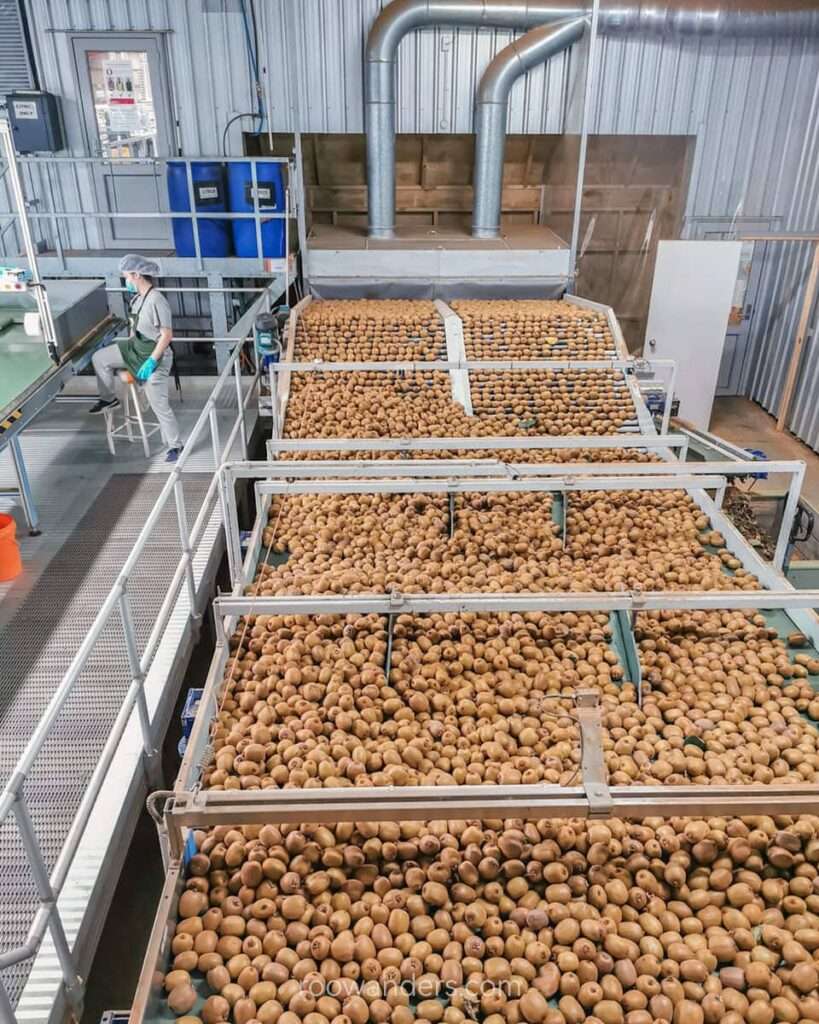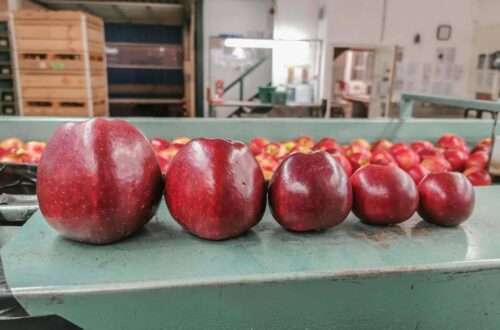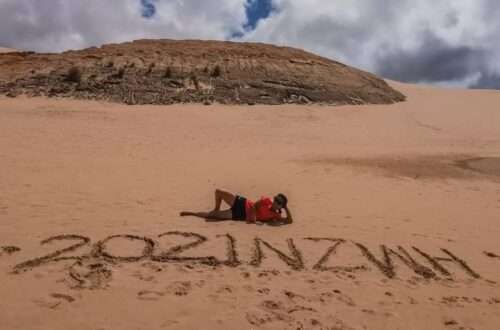
New Zealand Working Holiday #10: Kiwi Grading
Te Puke – The Capital of Kiwi Fruits.
That was what every motorist would have noticed before entering the small town. Those words were conveniently etched below the town’s speed limit sign.
And it was rightly pointed out.
Almost all kiwi fruits are produced in and around this self-proclaimed ‘capital’ located at the Bay of Plenty. Apart from the road signages, there are humongous cut kiwi fruit or kiwi slices scattered around the state.
Before I signed up as a kiwi grader, I was a blueberry picker at Hastings. After the stint ended, I went to rear lambs over Winter. Find all my quirky stories and guides about my awesome covid-induced, hyper-extended two-year-long working holiday in New Zealand here!

I graded kiwi fruits in Jul 2021. This post may be updated periodically.
History of The Kiwi
The fruit was not called the kiwi at the beginning. There were several names before that before ‘kiwi’ finally stuck.
Its history is as such: A school principal returned from a missionary trip in China. In her pockets were seeds of a peculiar fruit never before seen in New Zealand. She planted the seeds and tended the plants until they bore fruits. The taste of the fruits vaguely reminded the people then of the closest fruit they knew of – gooseberry – and they decided to call it the Chinese Gooseberry.
But the name – the Chinese Gooseberry – was not good for export marketing during the 1950s. The idea of calling it the kiwifruit came about during multiple brainstorming. And that name has stuck ever since, shortened to the kiwi.
As a bilingual who interchange the Chinese and English names of the fruit, there’s something interesting I thought I’d share with my non-Chinese readers.
From the story above, the fruit is called the kiwifruit in English. How did the person who thought about it come out with the name? With a bit of imagination, it isn’t difficult to see the similarity between the endemic flightless kiwi bird of New Zealand and the fruit. The word kiwi is synonymous with all things New Zealand. Plus, the kiwifruit was first exported from New Zealand to the Western world.
It is a different story in Chinese. The hairy fruit has many names. It could be the Special or Peculiar Fruit (奇異果 Qíyì guǒ) – kind of self-explanatory for its strange appearance – the Macaques peach or pear (獼猴桃、獼猴梨), the hairy pear (毛梨), or the sheep peach (羊桃), to name a few, all of which were linked to its fuzzy appearance.
The Kiwi Packhouses
The kiwi fruit industry is big in New Zealand. The fruits are marketed under the brand Zespri to distinguish the fruit from other exporting countries like China, Chile and Italy.
There are namely three big kiwifruit packhouses in Te Puke: EastPack, Seeka and Trevelyan. Lots of manpower are needed during the peak harvest season between March to June. That is when thousands of workers power through the picking, grading, packing, and shipping of the fruits to shops around the world.
Big packhouses guarantee a longer working term and better facilities. But there are also niche packhouses scattered across the region that promises closer interactions amongst the team.

Job Application and Expectations
Applying for a position in the packhouses is easy. Most packhouses have online application forms on their websites a couple of months before the season begins. Fill up those forms, and they will contact you.
During my stint with Trevelyan, I called their office a day before to enquire and walked in for the induction the following day. It was during the covid years after all, so the industry, as with the other industries that needed Working Holiday Visa holders, was facing a labour shortage. The demand for workers grew intense as more visa holders left the country, but none came in to replace them. Packhouses were dangling a minimum rate of $22.1/ hour, which is considerably higher than the minimum wage of $20 in 2021.
I am not sure if the same would have happened again once border restrictions are lifted. The last I heard (Nov 2021), a packhouse was proposing $26/ hour for fruit thinning (i.e. clearing excess fruit buds to promote the growth of higher-quality fruits).
Shifts
There are two shifts in big packhouses. A day shift usually begins at 7 am and ends at 5 pm or later, depending on the workload of the packhouse. A night shift starts after 6 pm. The packhouses essentially do not rest throughout the harvest season.
Induction
We filled up the usual forms – personal details, bank details, tax form – and received an apron and a booklet each during the induction. You could choose to work on that day or report to work the next day.
Entering The Premise
As with all food-handling/ -processing factories, jewellery, watches and loose clothing were prohibited in the packhouse. We have to wear hairnets and wash our hands whenever we enter the packing line.
Duties
What does one do in the packhouse?
Well, you could choose to be the generic worker: a grader, a packer, a stacker or the tray-dispenser. But if you’re lucky, you might be the person who prints the stickers for the boxes of kiwifruits. Or be the person who replenishes the rolls of stickers used on the kiwifruits. Or even be the person who counts the number of kiwifruits in a box once every other hour.
The Daily Kiwi Grind
Yours truly was selected as a grader, which was a pleasant change in job scope from my previous stint as an apple packer in Motueka last year.
So what does an average day as a kiwifruit grader in Trevelyan look like?
Firstly, let us understand the shifts operating in this packhouse.
Back in 2021, there were five five-day shifts in Trevelyan, coined as D1 – D5, and I was on D5. Shifts in Trevelyan operate on a rotational basis. As such the compound never sleeps. We worked on a work-four-rest-one roster.
Where and how did this roster come about?
There are four packing lines (or packhouses) in the compound. Each shift, from D1 to D4, works on its designated lines. As the fortunate – or unfortunate – members of shift D5, we do not have a permanent line. Instead, we rotate on whichever line that’s empty when the original shift working on that line is on a break.
All four packing lines in Trevelyan are different. From the ‘fast and furious’ automated grading line of Packhouse 4 to the ancient and often faulty line of Packhouse 1.
As a grader, we work on one of the many lanes in the grading area.
Grading area? Let us explore the different parts of a grading line!
A grading line is the lifeline of the packhouse. When the line stops working, you have nothing to do but go home.
Pre Grading

Crates of kiwifruits are poured onto a table of automated rolling belts. A handful of workers in this section clear out the ‘exploded’ kiwifruits or alien objects. Exploded or juice-contaminated kiwi cannot be sold as the fruits are prone to decay.
Grading
The good fruits roll through a series of brushes that rubbed away most of the dirt and dead leaves. The cleaner fruits get into the packhouse and onto the rolling tables of the graders.
Bulk grading works happen here. Graders have to differentiate the non-Class 1 fruits from the majority of exportable fruits. Some examples of non-Class 1 fruits include squarish kiwis, fruits with thick Hayward lines, sunburnt fruits, and flat kiwis. These fruits are Class 2 or Class 3 fruits.
Kiwi with birdlime (aka bird poo), scales (i.e. a kind of tenacious parasite), punctures and traces of exploded fruit juices go to the bin. Oddly shaped fruits, usually two to three fruit sizes too big for the chute, get dumped into a bucket.






The grader looks through thousands of rolling kiwi fruits every day. To the Class 1 fruits, he does nothing and lets them roll through to the grading machine. For the lower class fruits, he drops them into a funnel for further separation into Class 2 or 3. The bad kiwis go down another chute and into a bin.
Kiwifruits with birdlime (aka bird poo), scales (i.e. a kind of tenacious insect), punctures and traces of kiwifruit juices have to be discarded. Oddly shaped kiwifruits need to be sieved out too, but as they were usually two to three kiwifruit sizes too big for the chute, they were dumped into a bucket.
The Grading Machine
The good kiwi fruits then travel down the line and into the grading machine. Each fruit is weighed and has its photo taken within that split second in the machine. A sticker containing information such as the brand and code is also dispensed onto the fruit.
Packing
Each kiwi fruit sits on a plate that travels down the belt from the grading machine. Depending on the settings, the fruit falls into the packing lane that demands its weight.
Once the box is filled with kiwi fruits, it moves down the packing lane and onto the pallet. The pallet is subsequently transferred into cold storage.

The Kiwi Packhouse
Work started at 7 am, 7.15 am, or 7.30 am for D5, depending on the packhouses we had to work on that day. We were given two paid 15 mins tea breaks – one around 10 to 11 am and another around 3 to 4 pm. Lunch was 30 mins at about 12.30 pm. During the peak period, we clocked in on an average of nine hours every day.
The pantry in Trevelyan was well-equipped with microwaves and warmers. There are also water dispensers. Tea and coffee were complimentary for every break session.
Once in a while, the company organised events or had free food or fuel vouchers. We had a gumboot throwing competition during our tenure with them and enjoyed muffins almost every Saturday morning. During the peak packing period, there was a daily lucky draw. Three lucky workers were up for a day’s worth of double pay.
At the end of the harvest season, the company treated the staff to a buffet morning tea, and we had a short but fun dance battle.


General Working Conditions
Working with Trevalyan was pleasant. We graded gold and green kiwi fruits. Work was not tiring nor stressful as a generic worker until the KPI falls off the chart and the supervisors start to look glum. While we were working on a nine-hour long shift with a four-on-one-off roster, other major packhouses were doing twelve with an unforeseeable off-day.
Dealing with Boredom
Personal earphones were not permitted within the packhouses, but we do get a few who would secretly wear Bluetooth earbuds without being caught. Repetitive work does get boring after a while. Trevelyan has a stereo system for each lane, which makes work slightly more tolerable.
You may converse with the person opposite you, but this is usually frowned upon unless good grading performance is maintained.
Ending
My three months in a kiwi fruit packhouse were okay. Neither good nor bad but I made some good money I guess all is good. However, when compared to my first stint in the smaller apple packhouse, work then was fun, even though we suffered a lockdown. At least everyone knew each other by name. When the company is big, you stick to your own clique.
If it is an experience you are looking for and this is your first time working in a packhouse, go for it. After all, the kiwi fruit industry is always looking for people during the harvest season!








